
A sensitive new device can detect tiny amounts of norovirus in water. Credit: American Chemical Society
Made infamous by outbreaks on cruise ships, norovirus can really ruin a vacation, causing severe vomiting, diarrhea and stomach pain. But the highly infectious virus can also strike closer to home, with water- and foodborne outbreaks occurring in municipal water systems, schools, and restaurants. Today, researchers report a sensitive, portable device that can detect as few as a handful of norovirus particles in water.
The researchers will present their results at the American Chemical Society (ACS) Fall 2019 National Meeting & Exposition. ACS, the world’s largest scientific society, is holding the meeting in San Diego through Thursday, August 29, 2019. It features more than 9,500 presentations on a wide range of science topics.
Norovirus causes about 20 million cases of food poisoning in the U.S. every year. Researchers from the University of Arizona are working on an easy, inexpensive, and extremely sensitive way to detect norovirus using a cell phone and mostly off-the-shelf parts. The device could be deployed on cruise ships and other areas where labs are inaccessible. These research findings were presented at the American Chemical Society’s Fall 2019 National Meeting and Exposition in San Diego.
“It only takes a very small number of norovirus particles to cause an infection in humans, so we need a really sensitive detection method,” says Jeong-Yeol Yoon, Ph.D., who led the team. “Also, scientists aren’t able to culture norovirus in the lab, and available antibodies to the pathogen aren’t very strong.” As a result, detecting very small amounts of norovirus in water or food samples typically involves a polymerase chain reaction (PCR)-based method, which takes several hours and must be conducted in a lab by trained personnel.
In previous work, Yoon and his colleagues at the University of Arizona developed a smartphone-based device that could detect low levels of norovirus by measuring the light scattered from virus-bound polystyrene beads in a paper microfluidic chip. “Even though our detection limit was really low, the problem was that norovirus can be infectious at even lower concentrations,” Yoon says. “When we talked about this work at conferences, the feedback we received was that we need to provide an even easier method that can detect much lower concentrations of virus.”
So the team went back to the lab and developed a new approach that uses fluorescence, rather than light scattering, to detect norovirus. The researchers converted an ordinary smartphone into a fluorescence microscope by attaching a commercially available light microscope accessory, a separate light source, and two band-pass filters. To a channel of their paper microfluidic chip, they added a water sample containing norovirus. Then, the researchers added a suspension of fluorescent beads with antibodies against norovirus attached to them. The capillary action of the paper caused the two liquids to flow and mix. Each individual norovirus particle bound to multiple fluorescent beads via their attached antibodies, causing the beads to aggregate and produce a much larger size of fluorescent image.
The team snapped photos of the chip with their smartphone-based fluorescence microscope, and an app calculated norovirus concentrations from the pixel count of the images. “The lowest detection limit corresponded to about 5 or 6 norovirus particles per sample, so it’s very close to the single-virus level,” Yoon says. Because as few as 10 virus particles can cause illness in people, the new method is sensitive enough for practical applications.
Recently, Yoon and colleagues made the system more compact and handheld by enclosing the fluorescent microscope, light source and optical filters in a 3D-printed case. They also developed a cloud-computing app to analyze the large images and send the results back to the smartphone. In addition, they found a way to concentrate samples within the paper chip so they can analyze much larger sample volumes.
The device could detect minuscule amounts of norovirus in both purified water and reclaimed wastewater, which is very dirty. Tap water, on the other hand, was prone to error. “We believe that the chlorine in tap water is affecting the assay,” Yoon says. “We don’t think it will be a problem to treat the water to remove chlorine before performing our method.” Yoon envisions that municipal water systems staff could use the device and app to check for norovirus in the water supply. To test use of the assay in the field, the team is collaborating with Kelly Reynolds, Ph.D., at the same institution, as well as Tucson Water.
Now, Yoon and colleagues are working on using their smartphone-based device for diagnosing norovirus infections in patients at an earlier stage than is currently possible. To do this, they plan to analyze fecal samples. “When norovirus reaches levels detectable by other methods, the person is already seriously ill,” Yoon says. “But if we can detect the virus earlier, they can receive medical care sooner.” Early detection might also help curb the spread of disease in isolated, crowded situations like cruise ships, where distinguishing between a run-of-the-mill upset stomach and a norovirus infection could guide quarantine efforts or expedite getting a passenger to port for treatment.
For more on this technology, see Using a Smartphone to Detect Norovirus.
Reference: “Smartphone-Based Paper Microfluidic Particulometry of Norovirus from Environmental Water Samples at the Single Copy Level” by Soo Chung, Lane E. Breshears, Sean Perea, Christina M. Morrison, Walter Q. Betancourt, Kelly A. Reynolds, and Jeong-Yeol Yoon, June 27, 2019, ACS Omega.
DOI: 10.1021/acsomega.9b00772


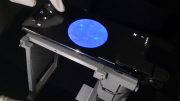
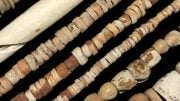

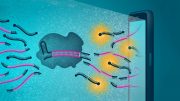
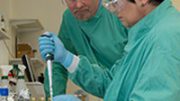
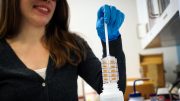
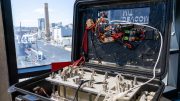
Be the first to comment on "Smartphone Norovirus (‘Cruise Ship’ Microbe) Detector [Video]"